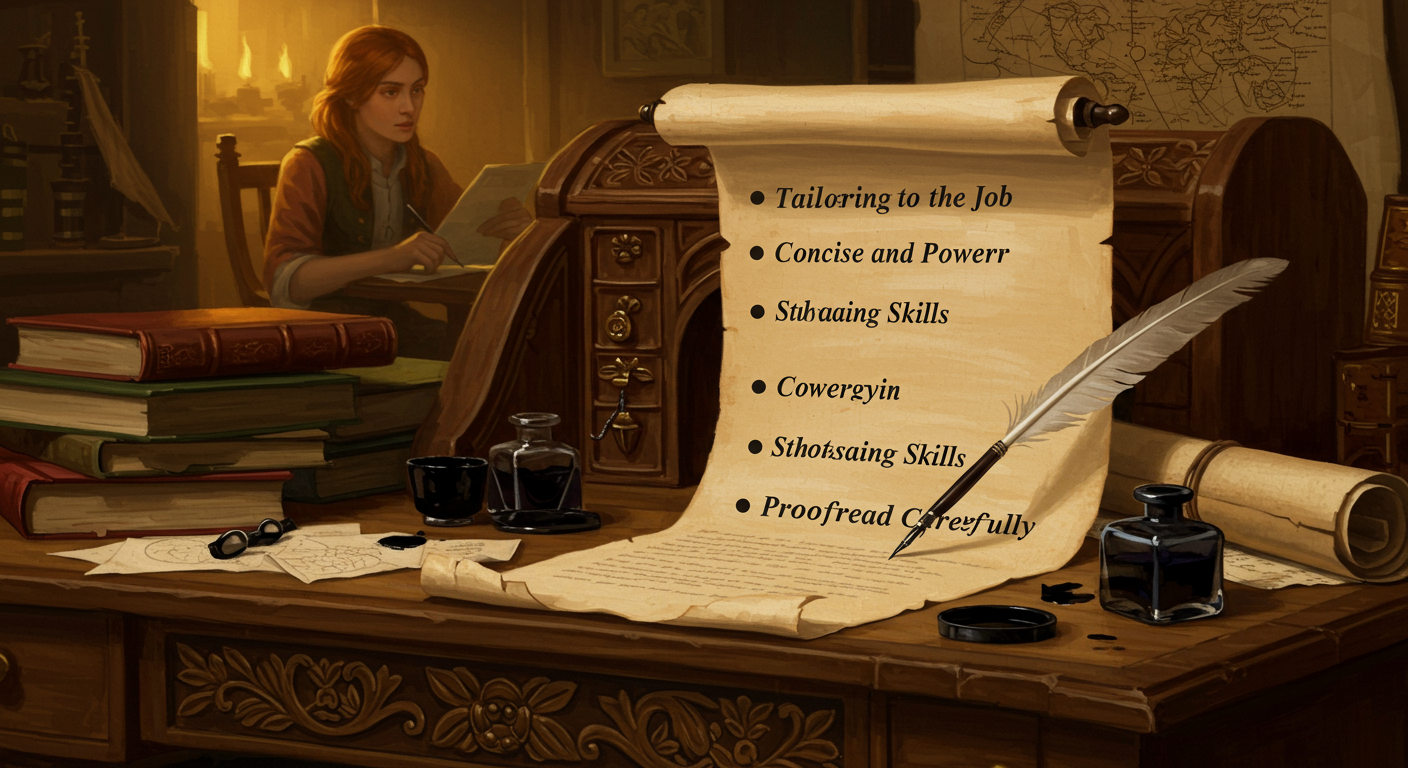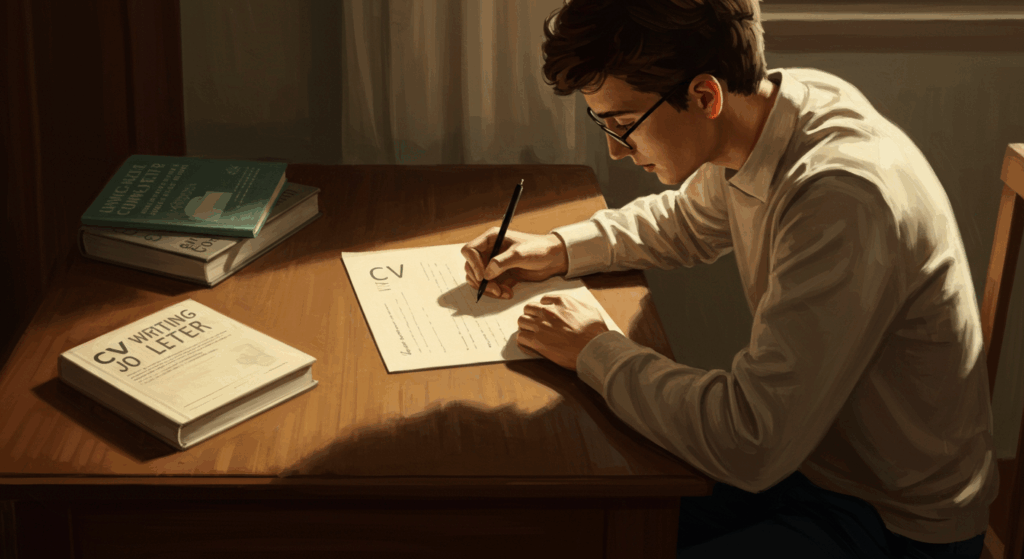Let’s Make Your Cover Letter Not Suck (in a nice way)
Okay, real talk: “Create a cover letter” sounds like homework your least favorite teacher assigned at 4:59 pm on a Friday. But here’s the thing—done right, a cover letter can do heavy lifting your resume can’t. It adds context, voice, and a lil bit of personality (like you, but in Times New Roman). Think of it as a DM to the hiring manager that says, “hey, I read your profile and I’m not just swiping right on every job in the app.”
This comprehensive guide is basically the friend-on-FaceTime version of cover letter help. We’ll go over the key elements, practical writing strategies, and examples you can remix for your own vibe. And we’ll keep it casual—some jokes, a few “hmm” moments, and little imperfections to prove a human was here. Ngl, you’ll finish this with a cover letter that actually makes you look good.
Grab a drink. Let’s do it.
Why Cover Letters Still Matter (Yes, in 2025)
If you’re wondering whether anyone reads cover letters, the answer is: sometimes. And that “sometimes” is enough to matter. When they do read it, it often becomes the tiebreaker between two great resumes. A thoughtful letter can:
- Tell your story (like “why this job, why this company, why now?”).
- Connect dots your resume can’t (career pivots, gaps, unique wins).
- Prove you understand their problems and can solve them.
- Show effort. Effort stands out—especially when 80% of letters look like copy/paste soup.
So yeah, keep it. Make it good. Keep it short-ish. And tailor it so it doesn’t scream template.
The Key Elements of a Great Cover Letter
These are the key elements that make your letter feel intentional, skimmable, and employer-friendly:
- Contact Header
- Your name, phone, email, LinkedIn/portfolio (keep links short and clean).
- Company name, role title, and date (yes, the date—grown-up stuff).
- Greeting
- Use a name if you can. “Hi Jordan Ramirez,” or “Dear Hiring Team at BloomTech.”
- Avoid “To Whom It May Concern” (it concerns all and yet no one).
- Hooky Opening (1–2 sentences)
- Lead with a quick win, an insight about the company, or a relevant connecytion.
- Make them want to read the next line. No “I’m writing to apply…” opener, pls.
- Body That Proves Fit (1–2 short paragraphs)
- Show how you meet the top 2–3 requirements, using specifics and numbers.
- Use a mini STAR (Situation, Task, Action, Result) to keep it crisp.
- Mirror their language a bit—if they say “customers,” don’t say “clients.”
- Culture & Motivation (1 paragraph, even 2–3 sentences works)
- Why this company? Drop a detail from their product, mission, or recent launch.
- Show your values match theirs (without sounding like a poster).
- A Clear Close + Call to Action
- One sentence: “I’d love to discuss how I can help X in Y timeframe.”
- Thank them. Keep energy high but not desperate.
- Signature
- “Warmly,” “Best,” or if you’re chill, “Thanks again,” + your name.
- Include your links again below if you want (optional).
- Optional P.S.
- A cheeky line can help (referral, relevant project, “I built a prototype,” etc.).
- P.S. can be the candy at the end that gets remembered.
Writing Strategies That Actually Work (and don’t feel cringe)
Consider these writing strategies the difference between a “meh” letter and one that vibes with busy humans:
- Start with the job description T-chart.
On the left: their top needs. On the right: your matching wins. Now your letter writes itself. - Use the Rule of 3.
Give them three meaty, quantified examples. Not seven vague ones. - Mini STAR > life memoir.
“Cut onboarding time 45% by automating flow in Zapier” beats “I was responsible for onboarding.” - Borrow their language (lightly).
If they value “ownership” and “experimentation,” echo that. Don’t go full parrot. - Quantify everything you can.
Numbers stop the scroll: 12% churn ↓, 150 tickets/week, $420k pipeline, 3-week rollout, etc. - Write like you speak—polished.
Conversational but clean. A dash of humor is fine; chaos is not. - One page max.
Honestly, 300–450 words is chef’s kiss. The hiring manager is reading on a phone between meetings, probably. - Personalize the “why us.”
Mention a feature you love, a campaign they ran, a customer segment you understand. Be specific. - ATS-aware, human-first.
Include a few keywords from the posting so the system doesn’t snooze on you, but write for an actual person. - File name matters.
Taylor_Nguyen_CoverLetter_ProductManager.pdf>final_final2.docx. Recruiters drag files. Make it clear.
A Comprehensive Guide: Step-by-Step to Create Your Cover Letter
Here’s your no-drama, do-this-then-that process. Keep it handy; it’s the comprehensive guide version, but still human.
1) Decode the Job in 7 Minutes
- Skim the posting for the top 3 requirements (usually repeated).
- Note the verbs (own, build, scale), the metrics, and the tools (Figma, HubSpot).
- Write a quick list: “They want X, Y, Z. I have A, B, C that match.”
2) Choose a Clean Format
- Margins 1″, font 11–12 pt, single spacing with a blank line between paragraphs.
- Keep it one page max (shoot for 300–450 words).
- Put your contact info at top; align the rest left (no weird text boxes that break ATS).
3) Lead With a Hook, Not a Yawn
- “I grew monthly demo-to-close by 22% at Orbit, and I’d like to bring the same playbook to your B2B pipeline” > “I’m applying for…”
- If you have a referral, name-drop kindly: “Ari Chen suggested I reach out.”
4) Prove You Can Do the Work (Core Wins)
- Tie 2–3 bullet-level wins into short paragraphs.
- Use numbers. Use action verbs. If you don’t have numbers, use frequency or scale.
5) Show You Get Them (Values + Product)
- Call out a product feature, initiative, or mission point you genuinely like.
- Connect your experience to it: “My last role focused on underserved SMBs too—here’s what I learned.”
6) Ask for a Next Step
- “I’d love to chat about accelerating your onboarding funnel this quarter.”
- Keep it confident and clear, not pushy.
7) Proof & Polish (The 5-Minute Cleanup)
- Read it out loud. If you get bored, shorten it.
- Fix typos (two passes). Check names and titles exactly.
- Save as PDF unless they specifically want a doc.
8) Name & Send Like a Pro
- File name:
First_Last_CoverLetter_Role_Company.pdf. - Email subject line: “Application – Product Designer – First Last.”
- Attach resume, link portfolio, done.
Formatting Essentials (Because aesthetics matter, sorry)
- Font: Calibri, Cambria, Georgia, Helvetica, Arial, or Times New Roman (11–12 pt).
- Length: 3–6 paragraphs, ~300–450 words.
- Margins: 1″ (don’t get cute).
- Spacing: Single, with blank lines between paragraphs; no dense walls.
- Header: Name big on top; contact info clean; links clickable.
- Consistency: Match the style of your resume (same font + header style) for a cohesive feel.
- File type: PDF unless asked otherwise.
- Accessibility: Meaningful link text (“View my portfolio”) not just raw URLs.
Example Openings You Can Remix
Use these as templates, not scripts. Add your wins. Make them yours.
Impact-led:
“Last quarter I reduced onboarding time by 38% by simplifying our tutorial flow—exactly the kind of customer friction I’d love to tackle at Nova’s mobile app.”
Referral-led:
“Jordan Reyes encouraged me to apply for your Growth Analyst role—after testing your free tier for two weeks, I have three ideas to improve trial-to-paid.”
Mission-led:
“As a first-gen grad who relied on scholarships, your ‘education-for-all’ mission lands deeply with me. I’d like to build content that gets more students funded, faster.”
Product-nerd:
“I’m obsessed with your beta feature that auto-categorizes receipts (seriously, chef’s kiss). I can help adoption ramp faster—at my last role I doubled daily active users in 90 days.”
Short Example Letters (Steal the skeleton, keep your voice)
Example 1 — Entry-Level Marketing
Hi Maya Singh,
When I increased campus event turnout by 54% in one semester (mostly by turning our sleepy Instagram into a meme-forward content machine), I realized I like turning attention into action. I’d love to bring that energy to BrightField’s Marketing Coordinator role.
In my internship at Finch & Co., I built a monthly content calendar, A/B tested hooks, and improved email CTR from 2.1% to 3.9% by tightening subject lines and simplifying CTAs. I also tracked performance in Notion/Sheets and presented wins to our small (but mighty) team every Friday—so yes, I can nerd out on metrics and still explain them clearly.
I’m especially drawn to BrightField’s commitment to transparent pricing (bless) and your blog’s honest case studies. That tone is rare and, ngl, refreshing. I’d love to help ship approachable SEO content and snackable social that nudges trials into signups.
I’d be excited to chat about how I can help your content engine punch above its weight this quarter. Thanks for your time!
Warmly,
Leah Gomez
leahgomez.dev | linkedin.com/in/leahgomez
P.S. I attached 3 reels—two got >20k organic views on a student account with ~1.4k followers. Tiny but mighty!
Example 2 — Mid-Level Software Engineer
Dear Hiring Team,
At LatticeCloud, I led a project that cut API response times by 41% (Node + Redis + aggressive query hygiene). Your posting for a Backend Engineer mentions similar scaling pains, which is exactly the kind of problem I love to solve.
Beyond sped, I care about developer happiness. I introduced lightweight standards (pre-commit hooks, better logs, small ADRs) that reduced production incidents by ~30% within two quarters. I’m comfortable mentoring, code reviewing with kindness, and writing docs that don’t feel like dental work.
I’m excited by your focus on privacy-first collaboration tools. After poking your public docs and trying the free tier, I have thoughts on request batching opportunities and a couple caching layers that might eliminate cold-start hiccups.
I’d welcome a chat about how I can help stabilize and scale your platform over the next 6–9 months.
Best,
Marcus Lee
github.com/marcuslee | marcuslee.dev
Example 3 — Career Pivot to UX
Hi Amina,
I’m a former teacher turned UX designer who’s very good at turning chaos into clarity. In the classroom I reimagined a parent portal that 100+ families used every week; now I’d like to bring that empathy and systems thinking to Cedar’s UX team.
In my capstone, I led research with 12 participants, translated findings into two personas, and shipped a high-fidelity prototype that improved task completion from 58% to 84% in testing. Tools: Figma, Maze, and a frankly unhinged amount of sticky notes.
Cedar’s focus on inclusive design feels aligned with my background. If helpful, I can share examples where multilingual labels and icon tweaks reduced confusion without adding dev scope.
Thanks for considering. I’d love to learn more about your roadmap and where I can plug in quickly.
Thanks again,
Renata Cruz
Portfolio: renatacruz.design | LinkedIn: /in/renatacruz
Common Mistakes (and how to fix them fast)
- Mistake: “I’m excited to apply for [wrong company]…”
Fix: Triple-check names. Copy the company name last. - Mistake: Writing your autobiography.
Fix: 300–450 words. 2–3 quantified wins tied to their needs. - Mistake: Vague fluff like “hard-working team player.”
Fix: One concrete example with a number beats five adjectives. - Mistake: No “why us.”
Fix: One sentence about their product, customers, or mission—show you care. - Mistake: Wall of text.
Fix: Short paragraphs. White space. Breathe. - Mistake: Oversharing personal details to fill space.
Fix: Re-center on how you’ll help them hit metrics or ship projects. - Mistake: Sounding robotic.
Fix: Read it out loud. If it doesn’t sound like you (but professional), tweak.
Upgrading Your Letter: Advanced Writing Strategies
When you want to go from solid to standout, layer these writing strategies:
- The “3 Problems, 3 Solutions” Frame
From the posting, pick three challenges (e.g., “improve onboarding,” “increase retention,” “launch in APAC”). Offer a one-liner for each: what you did before + how you’d approach it here. - Outcomes > Responsibilities
“Owned weekly release calendar” is fine. “Reduced release rollbacks 25% by adding staging smoke tests” is memorable. - Micro-Portfolio Mentions
Name drop a relevant artifact: “Here’s a 2-page teardown of your onboarding I did for fun.” (Keep it high signal, not 30 pages.) - Values Alignment
If their mission matters to you, say why in one sentence. Avoid clichés. Authentic > perfect. - P.S. with Extra Sauce
“P.S. Happy to share the script I used to prune flaky tests—cut CI time by ~9 minutes.”
The 10-Minute Tailoring Hack
Short on time? I got you. Here’s the speed-run:
- Copy your base letter (the one that already has your best 2–3 wins).
- Replace the company name/role everywhere.
- Find 1 specific detail about the company to mention (feature, customer story, news, mission point).
- Mirror 2–3 keywords from the job description (tools, responsibilities).
- Swap 1 example if needed to better match this role.
- Read it aloud once. Trim a sentence. Save as PDF. Send.
That’s it. Seriously.
FAQs You Might Be Thinking (while doomscrolling)
How long should a cover letter be?
300–450 words is the sweet spot; one page max. If you’re going long, try a bullet list in the middle.
Do I need a name in the greeting?
Nice-to-have, not required. If you can’t find one, “Hi [Team Name]” works.
What if I have no experience?
You do. Projects, internships, school leadership, part-time gigs all count. Translate them into outcomes (“grew attendance by 40%,” “resolved 30 tickets/week,” “built prototype with 3 users testing”).
Should I use AI to write it?
Use it like a writing buddy, but keep your voice. Always edit. Add your numbers, your actual wins, your personallity.
Cover letter in the email body or as an attachment?
If they don’t specify, attach as a PDF and paste a snappier version into the email body (shorter intro + the sharpest paragraph).
What if I’m changing careers?
Name the pivot + bridge the skills. Show 1–2 projects proving transfer, and keep your energy confident.
A Quick “Comprehensive Guide” Checklist (Print this if you’re old-school)
- Contact header clean, links working.
- Greeting human (name if possible).
- Opening hook with a result or insight.
- Two or three quantified wins tied to their needs.
- One sentence about why this company.
- Clear close with request to chat.
- Proofread twice; names correct.
- File named like a pro; PDF unless told otherwise.
This tiny checklist is the comprehensive guide in checklist form. Use it every time so your letters stay crisp and consistent.
Bonus: Mini Templates by Role (Fill-in-the-blanks)
Sales / SDR
“Last quarter I booked [#] meetings and sourced [$] in pipeline by [tactic]. I’m excited to bring that playbook to [Company], especially given your focus on [ICP/segment]. I’m comfortable with [toolstack] and love friendly competition (I have the team trophy for [silly brag]).”
Ops / Project Management
“I cut [process] cycle time by [%] by [change], which saved [hours/$] per month. I noticed your goal to [goal from posting]—happy to help build a lightweight operating cadence with [tools/rituals].”
Content / Social
“I grew [channel] from [baseline] to [result] by [specific strategy] and upleveled CTR by [%]. Your audience cares about [topic], and I’ve got 3 post ideas ready to test next week.”
Design / UX
“In user tests with [#] participants, my redesign improved task success from [%] to [%]. I’d love to partner with PM/Eng to ship usable v1s fast, then iterate.”
Data / Analytics
“I built a dashboard that surfaced [metric] anomalies daily, which helped cut [bad outcome] by [%]. I can help you standardize definitions and make sure teams make decisions with the same truth.”
What Makes This a “Comprehensive Guide” (and not just another listicle)
You’ve got the key elements, the practical writing strategies, and the done-for-you examples—plus the speed-run method. But more importantly, you now have a way to think about cover letters: they’re not essays, they’re little business cases. You’re saying, “Here’s how I’ve driven results before, here’s why your company matters to me, and here’s what I’m excited to help with next.” That’s it. No drama.
And yeah, it’s okay if it’s not perfect. Perfect is suspicious anyway. Aim for clear, honest, and specific. Sprinkle in a tiny bit of you—your humor, your values, your obsession with clean dashboards or clever headlines or shaving milliseconds off load times. That’s the sauce.
Wrap-Up (You’ve got this)
If you made it this far, you’re not just “creating a cover letter”—you’re building a tool that opens doors. Keep this comprehensive guide nearby, use the writing strategies that fit your style, and focus on the key elements that show you get what they need and you can deliver.
Now go write the letter. Then send it. Then celebrate with something nice (cookie? iced coffee? a full episode instead of 12 TikToks?). You’re closer than you think.
Call to action: Pick one job posting, set a 20-minute timer, and draft your letter using the 10-minute tailoring hack above. Hit send before the timer runs out. Future you will be proud—promise.









